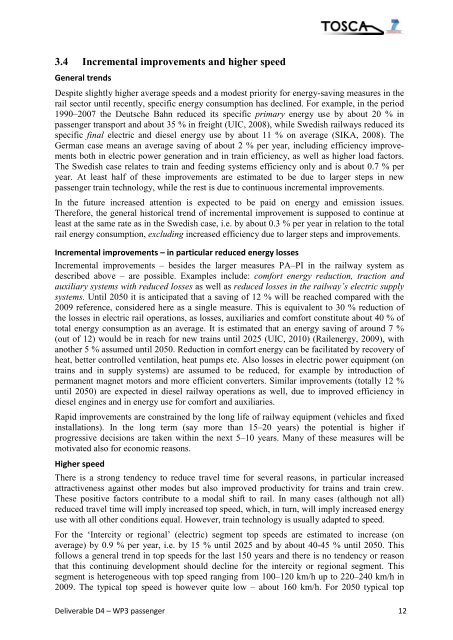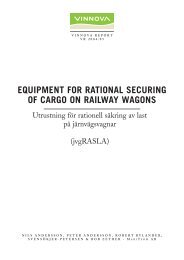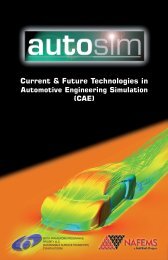WP3: Rail Passenger Transport - TOSCA Project
WP3: Rail Passenger Transport - TOSCA Project
WP3: Rail Passenger Transport - TOSCA Project
Create successful ePaper yourself
Turn your PDF publications into a flip-book with our unique Google optimized e-Paper software.
3.4 Incremental improvements and higher speed<br />
General trends<br />
Despite slightly higher average speeds and a modest priority for energy-saving measures in the<br />
rail sector until recently, specific energy consumption has declined. For example, in the period<br />
1990–2007 the Deutsche Bahn reduced its specific primary energy use by about 20 % in<br />
passenger transport and about 35 % in freight (UIC, 2008), while Swedish railways reduced its<br />
specific final electric and diesel energy use by about 11 % on average (SIKA, 2008). The<br />
German case means an average saving of about 2 % per year, including efficiency improvements<br />
both in electric power generation and in train efficiency, as well as higher load factors.<br />
The Swedish case relates to train and feeding systems efficiency only and is about 0.7 % per<br />
year. At least half of these improvements are estimated to be due to larger steps in new<br />
passenger train technology, while the rest is due to continuous incremental improvements.<br />
In the future increased attention is expected to be paid on energy and emission issues.<br />
Therefore, the general historical trend of incremental improvement is supposed to continue at<br />
least at the same rate as in the Swedish case, i.e. by about 0.3 % per year in relation to the total<br />
rail energy consumption, excluding increased efficiency due to larger steps and improvements.<br />
Incremental improvements – in particular reduced energy losses<br />
Incremental improvements – besides the larger measures PA–PI in the railway system as<br />
described above – are possible. Examples include: comfort energy reduction, traction and<br />
auxiliary systems with reduced losses as well as reduced losses in the railway’s electric supply<br />
systems. Until 2050 it is anticipated that a saving of 12 % will be reached compared with the<br />
2009 reference, considered here as a single measure. This is equivalent to 30 % reduction of<br />
the losses in electric rail operations, as losses, auxiliaries and comfort constitute about 40 % of<br />
total energy consumption as an average. It is estimated that an energy saving of around 7 %<br />
(out of 12) would be in reach for new trains until 2025 (UIC, 2010) (<strong>Rail</strong>energy, 2009), with<br />
another 5 % assumed until 2050. Reduction in comfort energy can be facilitated by recovery of<br />
heat, better controlled ventilation, heat pumps etc. Also losses in electric power equipment (on<br />
trains and in supply systems) are assumed to be reduced, for example by introduction of<br />
permanent magnet motors and more efficient converters. Similar improvements (totally 12 %<br />
until 2050) are expected in diesel railway operations as well, due to improved efficiency in<br />
diesel engines and in energy use for comfort and auxiliaries.<br />
Rapid improvements are constrained by the long life of railway equipment (vehicles and fixed<br />
installations). In the long term (say more than 15–20 years) the potential is higher if<br />
progressive decisions are taken within the next 5–10 years. Many of these measures will be<br />
motivated also for economic reasons.<br />
Higher speed<br />
There is a strong tendency to reduce travel time for several reasons, in particular increased<br />
attractiveness against other modes but also improved productivity for trains and train crew.<br />
These positive factors contribute to a modal shift to rail. In many cases (although not all)<br />
reduced travel time will imply increased top speed, which, in turn, will imply increased energy<br />
use with all other conditions equal. However, train technology is usually adapted to speed.<br />
For the ‘Intercity or regional’ (electric) segment top speeds are estimated to increase (on<br />
average) by 0.9 % per year, i.e. by 15 % until 2025 and by about 40-45 % until 2050. This<br />
follows a general trend in top speeds for the last 150 years and there is no tendency or reason<br />
that this continuing development should decline for the intercity or regional segment. This<br />
segment is heterogeneous with top speed ranging from 100–120 km/h up to 220–240 km/h in<br />
2009. The typical top speed is however quite low – about 160 km/h. For 2050 typical top<br />
Deliverable D4 – <strong>WP3</strong> passenger 12
















